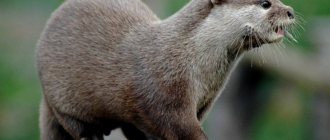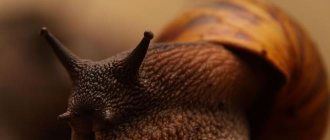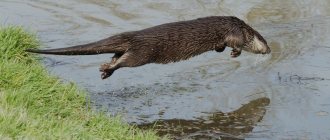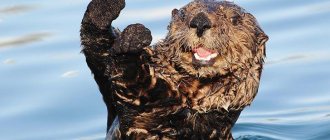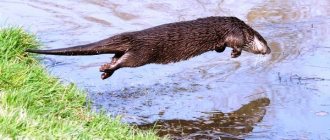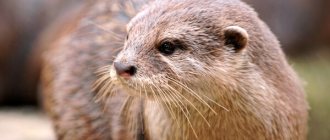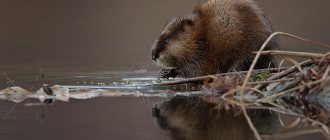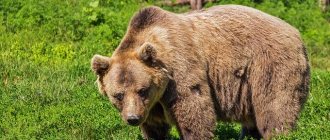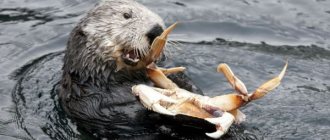Otters are unique, cute and playful creatures, with a characteristic appearance characteristic of animals that spend a lot of time in the water. In addition, they are also smart animals that can be trained to perform various tricks. These animals have some unique capabilities. Despite their small size, otters are able to withstand young alligators, and often emerge victorious in such fights. This article describes the behavior and lifestyle of these mammals.
Otters: description
Otters are members of the mustelidae family. These are predatory mammals, armed with powerful jaws with sharp and large teeth, curved in shape. This tooth structure allows otters to open mollusk shells. Sea otters have retractable claws on their forelimbs, which makes them very dangerous predatory animals.
Giant otter. The storm of alligators and an exemplary family man
Appearance
Depending on the species, otters may differ in both appearance and size. River otters have a long, streamlined body, short limbs, webbed toes, and long, conical tails. Such “weapons” are very important in the life of an otter, since it spends most of its life in water. The body of this animal is covered with a waterproof coat, which consists of coarser guard hairs, as well as dense undercoat. The upper part of the body is colored in shades of brown, and the lower part in lighter tones with a silver tint. Otters have to constantly clean their fur because dirty fur loses its effectiveness. This is especially true in winter, especially since these animals do not have a fat layer that would effectively retain heat.
Adult males grow up to 1 meter in length, or even more, weighing from 9 to 13 kilograms. Females are slightly smaller in size. Out of ignorance, river otters are often confused with sea otters, although this is not easy, since sea otters grow up to almost 2 meters in length and can weigh more than 3 tens of kilograms. Sea otters prefer to live in salt water, and appear near the coastal zone very rarely: they swim in to rest or reproduce. River otters also feel good on land, covering significant distances.
River otters are quite cheerful creatures, so you can watch them play on snowy banks or on slippery rocks. These animals were the reason for the appearance of their fun games on the Internet, as well as on the pages of printed publications, although nowadays everything can be seen on the World Wide Web. Their antics make literally every person smile. It should not be forgotten that this is a predatory animal.
Character and lifestyle
As a rule, otters prefer to lead a secretive lifestyle, choosing for their life activities an aquatic environment represented by various types of reservoirs, including in mountainous areas. Such animals that live in salt water must have access to fresh water, where they prefer to get rid of the salts that settle in their fur. Some species can mark their territories. Within this territory, otters have several points where they rest, and the resting places are often located at a considerable distance from the reservoir. These animals do not build nests for themselves, so they occupy beaver nests or find secluded places among rocks or in the roots of trees.
Interesting to know! River otters are active at any time of the day if they do not feel any threat from the outside, or the presence of a person. As a rule, while awake, they are busy with hygiene procedures, searching for food, and also playing underwater games. In addition, their activity is not related to the time of year, especially since these animals are constantly on the move. The only exception is the period of raising offspring, and then this applies only to females.
Otters are interesting to watch, but to do this you need to find a hill above the water and hide, remaining motionless. They have poor eyesight, so they are unlikely to be able to see a hidden person. It should be noted that they have an excellent sense of smell and hearing. You should not get too close to this animal, especially if it is a female with a litter. Its behavior is difficult to predict, although usually this animal will try to hide in the water column.
How long do otters live?
Living in their natural environment, these animals live on average up to 10 years, but in captivity and with proper care, the otter can live much longer.
Sexual dimorphism
It is extremely difficult to distinguish a female from a male, since they have almost the same appearance. The only difference is the size, since males are much larger than females.
Types of otters
Before 2012, there were 13 species of otters, but after the Japanese river otter was declared extinct, 12 species remained in the wild. Otters are found on almost all continents, with the exception of Australia and Antarctica. Some species lead an exclusively aquatic lifestyle, living in the waters of the Pacific Ocean.
Some species prefer to spend more time on land. This concerns the giant otter, which lives in the tropics of South America. As a rule, otters feed on seafood, in the form of fish, shellfish, lobsters, as well as small animals living in the coastal zone. The diet of giant otters includes piranhas, as well as small crocodiles.
The Eastern or Asian small-haired otter is considered the smallest representative of this family. This is a very beautiful and charming living creature, whose weight rarely reaches 4 and a half kilograms. They live in small groups, numbering on average up to 10 individuals. Their life activity is associated with wetlands, as well as the coastlines of various bodies of water in southern Asia. Unfortunately, the total number of these cute animals is constantly declining due to the disappearance of their natural habitat.
The most common species is the European or Eurasian otter. This type of mammal is not so picky about its diet, so it is quite extensive, which increases the chances of survival. The European otter lives throughout the Euro-Asian continent, including some places in North Africa. They prefer to lead a solitary lifestyle. They are active around the clock, and they can hunt both in water and on land.
Giant otters
Giant otters grow up to 2 meters or more in length, excluding the length of the tail, and their weight reaches 40 kilograms. The behavior and lifestyle of this species are characteristic of social animals and are similar to the behavior and lifestyle of predatory animals such as wolves. As a rule, in each of their groups there are Alpha pairs that have an advantage over other individuals, including in the reproduction of offspring.
Giant otters hunt in packs, so it is not difficult for them to cope with a crocodile, anaconda or monkey. Despite this, the basis of their diet is fish.
In addition, their diet includes invertebrates and small animals, including hares. Sea otters hold the record for weight, as their weight can reach fifty kilograms. Their natural habitats are associated with the vastness of the Pacific Ocean.
It is important to know! North American river otters grow in length up to 0.9-1.2 meters, gaining a maximum weight of 20 kilograms. They mostly live in groups, although there are also solitary individuals.
Sea otters spend their entire lives in the water. Even their eating process is unique: they lie on their backs, and their stomach serves as something like a dining table. Sea otters use sea stones to crack open shellfish shells, indicating intelligence.
They love holding hands while sleeping
Sea otters, especially mothers and calves, often hold hands while swimming on their backs. Hand holding prevents otters from moving away from their food source and each other while they sleep. They like to sleep wrapped in long strands of seaweed, like a blanket. The algae acts as an anchor and prevents them from floating away into the open ocean.
Photo: mana5280
Where do they live?
Otters can occupy vast territories, which mainly depends on the availability of food supply. The smallest territories are associated with coastal areas, the length of which is about 2 km, and the largest are located in the basins of mountain rivers, up to 20 km long. As a rule, males have larger such territories compared to the territories occupied by females, and sometimes these territories overlap. According to experts, the total number is about 10 thousand individuals.
In this territory, occupied by an individual, there are several nests, which can be located among rocks, in the roots of trees, as well as in other secluded places that are located along the coastline of reservoirs. Each resting place has several entrances that are not visible from the outside, which ensures safe living conditions. Otters do not form nests, but occupy abandoned burrows of beavers or hares. Otters also make sure that they have a backup nest, located away from the shoreline in case of high water.
What do otters eat?
The diet of river otters is very diverse, but the basis is still fish. They usually hunt fish that move slowly through the water. These are carp, mud minnow and others. Despite this, otters know when salmon spawn and can travel long distances to get enough to eat.
Interesting moment! River otters' metabolism is so fast that food eaten passes through the intestines in just 1 hour. Therefore, they have to hunt regularly, both during the day and at night.
The diet of river otters also includes other aquatic inhabitants, such as mussels, crayfish, amphibians, water beetles, small waterfowl, bird eggs, fish eggs, small rodents, etc. The end of winter is characterized by the fact that the water level in reservoirs drops and an empty air space forms between the water and the ice. Otters successfully use such features and hunt directly under the ice, going on a kind of journey.
Mothers have a lot of work to do
During the first month, the cubs cannot swim at all, despite the fact that they were born in water. The clean, fluffy fur retains heat and traps air, allowing them to swim. Mothers care for their babies and blow air through their clean fur to create buoyancy. The female wraps the baby in seaweed to secure it during the hunt. The cubs stay with their mother until they are one year old or until she has another litter.
Photo: Rebecca Campbell
Mothers spend up to 14 hours a day searching for enough food to meet the nutritional needs of their young. Intensive feeding leads to exhaustion of females, and many of them die even from minor illnesses.
Reproduction and offspring
Otters are able to breed all year round, but they do this in the onset of spring or early summer. The female secretes special aromatic substances that signal her readiness to mate.
After mating, the female carries her offspring for 2 months, after which several babies are born. As a rule, there can be 2-3 of them, although cases of the birth of 5 babies are known. Over the next 2 months, the female is busy dragging them along with her, appearing in her dwellings located at a considerable distance. After 2 months of life, the offspring practically become independent, but at the same time they do not leave the mother’s nest for up to six months, or even longer, before starting to create their own families.
How do they reproduce?
Otters become sexually mature at the age of 2-3 years. The breeding season occurs at different times depending on climatic conditions. Males may engage in fights for the right to cover the female, but fights are not aggressive and do not lead to significant injuries.
Otters are characterized by a period of latent pregnancy, the duration of which reaches 9 months. Childbirth occurs 2 months after the start of embryo development. The female gives birth to 2 to 4 blind cubs. At the moment of birth they weigh about 100 grams. By the end of the first month of life, babies' eyes open, and their weight is 600-800 grams. By three months, otter cubs go on their first hunt. At six months, young individuals are already completely independent, but continue to stay with their mother until 9-12 months.
Natural enemies of the otter
Sea otters are less vulnerable due to their speed and maneuverability. As for river otters, they are more vulnerable, especially when on land. Therefore, they can serve as lunch for many carnivorous mammals. Inexperienced young animals are especially vulnerable.
People catch otters when it is necessary to control the number of fish in private ponds or fish farms. The fur of these animals is in great demand because it has a number of excellent characteristics. If we talk about the global problems of reducing the number of these animals, they are associated with the process of environmental pollution, as well as changes in the landscapes of coastal areas as a result of soil erosion.
Evil sister of the honey badger! GIANT (BRAZILIAN) OTTER IN ACTION! Against jaguars, caimans, snakes!
Population and species status
Today it is known that about 3 thousand individuals of the Californian sea otter live in nature, as well as more than 150 thousand individuals of Alaskan and Russian sea otters. The number of Irish otters is at a stable level.
Interesting moment! It has now become known that the number of this animal species has begun to decline.
I would like to believe that a person will take all measures to eliminate this negative process.
Their appetite is enviable
Increased appetite is not unique to giant otters: all otters eat between 20 and 33 percent of their body weight every day. They spend almost five hours a day searching for food. Their menu includes sea urchins, clams, mussels and crabs.
Otters have loose skin in their armpits that acts as a storage area for rocks and food. Why do they need stones? Otters use stones as tools for opening shellfish. The otters' enormous appetite protects the kelp forests from sea urchins. Without sea otters, the urchin population is exploding and destroying kelp forest habitat.
